page 9 MITSUBISHI LANCER RALLIART 2014 8.G Owners Manual
[x] Cancel search | Manufacturer: MITSUBISHI, Model Year: 2014, Model line: LANCER RALLIART, Model: MITSUBISHI LANCER RALLIART 2014 8.GPages: 434, PDF Size: 57.5 MB
Page 380 of 434
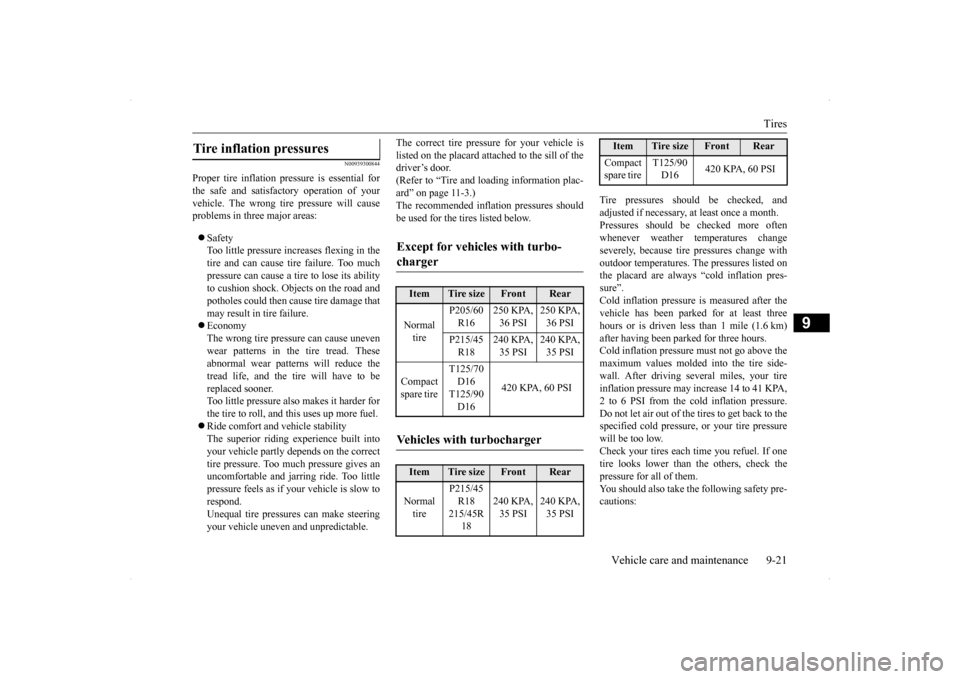
Tires
Vehicle care and maintenance 9-21
9
N00939300844
Proper tire inflation pressure is essential for the safe and satisfactory operation of yourvehicle. The wrong tire pressure will cause problems in three major areas: Safety Too little pressure increases flexing in thetire and can cause tire failure. Too muchpressure can cause a tire to lose its ability to cushion shock. Objects on the road and potholes could then cause tire damage thatmay result in tire failure. Economy The wrong tire pressure can cause unevenwear patterns in the tire tread. These abnormal wear patterns will reduce the tread life, and the tire will have to bereplaced sooner. Too little pressure also makes it harder for the tire to roll, and this uses up more fuel. Ride comfort and vehicle stability The superior riding experience built into your vehicle partly depends on the correcttire pressure. Too much pressure gives an uncomfortable and jarring ride. Too little pressure feels as if your vehicle is slow torespond. Unequal tire pressures can make steering your vehicle uneven and unpredictable.
The correct tire pressure for your vehicle is listed on the placard attached to the sill of the driver’s door. (Refer to “Tire and loading information plac-ard” on page 11-3.) The recommended inflation pressures should be used for the tires listed below.
Tire pressures should be checked, and adjusted if necessary, at least once a month. Pressures should be checked more often whenever weather temperatures changeseverely, because tire pressures change with outdoor temperatures. The pressures listed on the placard are always “cold inflation pres-sure”. Cold inflation pressure is measured after the vehicle has been parked for at least threehours or is driven less than 1 mile (1.6 km)after having been parked for three hours. Cold inflation pressure must not go above the maximum values molded into the tire side-wall. After driving several miles, your tire inflation pressure may increase 14 to 41 KPA, 2 to 6 PSI from the cold inflation pressure.Do not let air out of the tires to get back to the specified cold pressure, or your tire pressure will be too low.Check your tires each time you refuel. If one tire looks lower than the others, check the pressure for all of them.You should also take the following safety pre- cautions:
Tire inflation pressures
Except for vehicles with turbo- charger
Item
Tire size
Front
Rear
Normal tire
P205/60 R16
250 KPA, 36 PSI
250 KPA, 36 PSI
P215/45 R18
240 KPA, 35 PSI
240 KPA, 35 PSI
Compact spare tire
T125/70 D16 T125/90D16
420 KPA, 60 PSI
Vehicles with turbocharger
Item
Tire size
Front
Rear
Normal tire
P215/45 R18215/45R
18
240 KPA, 35 PSI
240 KPA, 35 PSI
Compact spare tire
T125/90 D16
420 KPA, 60 PSI
Item
Tire size
Front
Rear
Page 381 of 434
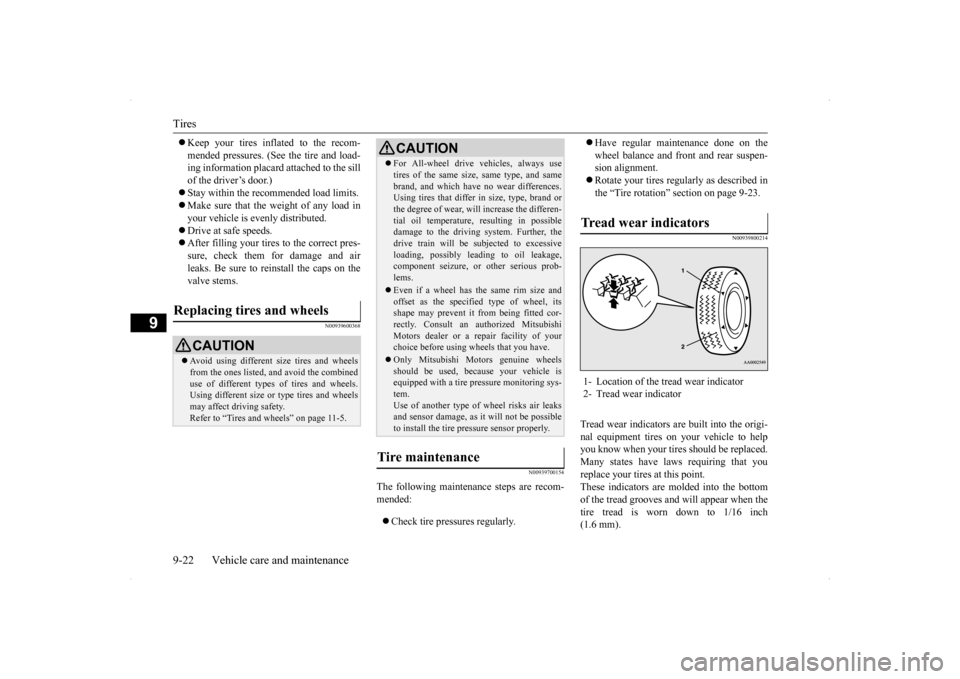
Tires 9-22 Vehicle care and maintenance
9
Keep your tires inflated to the recom- mended pressures. (See the tire and load- ing information placard attached to the sill of the driver’s door.) Stay within the recommended load limits. Make sure that the weight of any load in your vehicle is evenly distributed. Drive at safe speeds. After filling your tires to the correct pres- sure, check them for damage and airleaks. Be sure to reinstall the caps on thevalve stems.
N00939600368
N00939700154
The following maintenance steps are recom- mended: Check tire pressures regularly.
Have regular maintenance done on the wheel balance and front and rear suspen- sion alignment. Rotate your tires regularly as described in the “Tire rotation” section on page 9-23.
N00939800214
Tread wear indicators are built into the origi- nal equipment tires on your vehicle to help you know when your tires should be replaced.Many states have laws requiring that you replace your tires at this point. These indicators are molded into the bottomof the tread grooves and will appear when the tire tread is worn down to 1/16 inch (1.6 mm).
Replacing tires and wheels
CAUTION Avoid using different size tires and wheels from the ones listed, and avoid the combined use of different types of tires and wheels.Using different size or type tires and wheels may affect driving safety. Refer to “Tires and wheels” on page 11-5.
For All-wheel drive vehicles, always use tires of the same size, same type, and same brand, and which have no wear differences. Using tires that differ in size, type, brand or the degree of wear, will increase the differen-tial oil temperature, resulting in possible damage to the driving system. Further, the drive train will be subjected to excessiveloading, possibly leading to oil leakage, component seizure, or other serious prob- lems. Even if a wheel has the same rim size and offset as the specified type of wheel, itsshape may prevent it from being fitted cor- rectly. Consult an authorized Mitsubishi Motors dealer or a repair facility of yourchoice before using wheels that you have. Only Mitsubishi Motors genuine wheels should be used, because your vehicle is equipped with a tire pressure monitoring sys- tem.Use of another type of wheel risks air leaks and sensor damage, as it will not be possible to install the tire pressure sensor properly.
Tire maintenance
CAUTION
Tr e a d w e a r i n d i c a t o r s 1- Location of the tread wear indicator 2- Tread wear indicator
Page 385 of 434
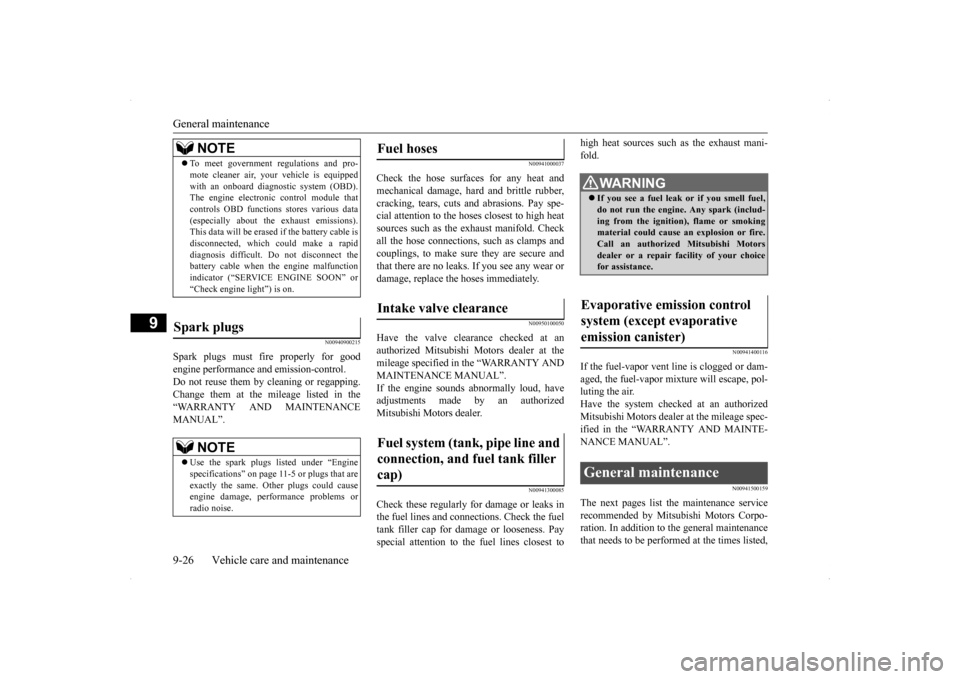
General maintenance 9-26 Vehicle care and maintenance
9
N00940900215
Spark plugs must fire properly for good engine performance and emission-control.Do not reuse them by cleaning or regapping. Change them at the mileage listed in the “WARRANTY AND MAINTENANCEMANUAL”.
N00941000037
Check the hose surfaces for any heat andmechanical damage, hard and brittle rubber,cracking, tears, cuts and abrasions. Pay spe- cial attention to the hoses closest to high heat sources such as the exhaust manifold. Checkall the hose connections, such as clamps and couplings, to make sure they are secure and that there are no leaks. If you see any wear ordamage, replace the hoses immediately.
N00950100050
Have the valve clearance checked at anauthorized Mitsubishi Motors dealer at themileage specified in the “WARRANTY AND MAINTENANCE MANUAL”. If the engine sounds abnormally loud, haveadjustments made by an authorized Mitsubishi Motors dealer.
N00941300085
Check these regularly for damage or leaks in the fuel lines and connections. Check the fuel tank filler cap for damage or looseness. Pay special attention to the fuel lines closest to
high heat sources such as the exhaust mani- fold.
N00941400116
If the fuel-vapor vent line is clogged or dam- aged, the fuel-vapor mixture will escape, pol- luting the air.Have the system checked at an authorized Mitsubishi Motors dealer at the mileage spec- ified in the “WARRANTY AND MAINTE-NANCE MANUAL”.
N00941500159
The next pages list the maintenance servicerecommended by Mitsubishi Motors Corpo- ration. In addition to the general maintenance that needs to be performed at the times listed,
NOTE
To meet government regulations and pro- mote cleaner air, your vehicle is equipped with an onboard diagnostic system (OBD). The engine electronic control module that controls OBD functions stores various data(especially about the exhaust emissions). This data will be erased if the battery cable is disconnected, which could make a rapiddiagnosis difficult. Do not disconnect the battery cable when the engine malfunction indicator (“SERVICE ENGINE SOON” or“Check engine light”) is on.
Spark plugs
NOTE
Use the spark plugs listed under “Engine specifications” on page 11-5 or plugs that are exactly the same. Other plugs could causeengine damage, performance problems or radio noise.
Fuel hoses Intake valve clearance Fuel system (tank, pipe line and connection, and fuel tank filler cap)
WA R N I N G If you see a fuel leak or if you smell fuel, do not run the engine. Any spark (includ- ing from the ignition), flame or smokingmaterial could cause an explosion or fire. Call an authorized Mitsubishi Motors dealer or a repair facility of your choicefor assistance.
Evaporative emission control system (except evaporative emission canister) General maintenance
Page 387 of 434
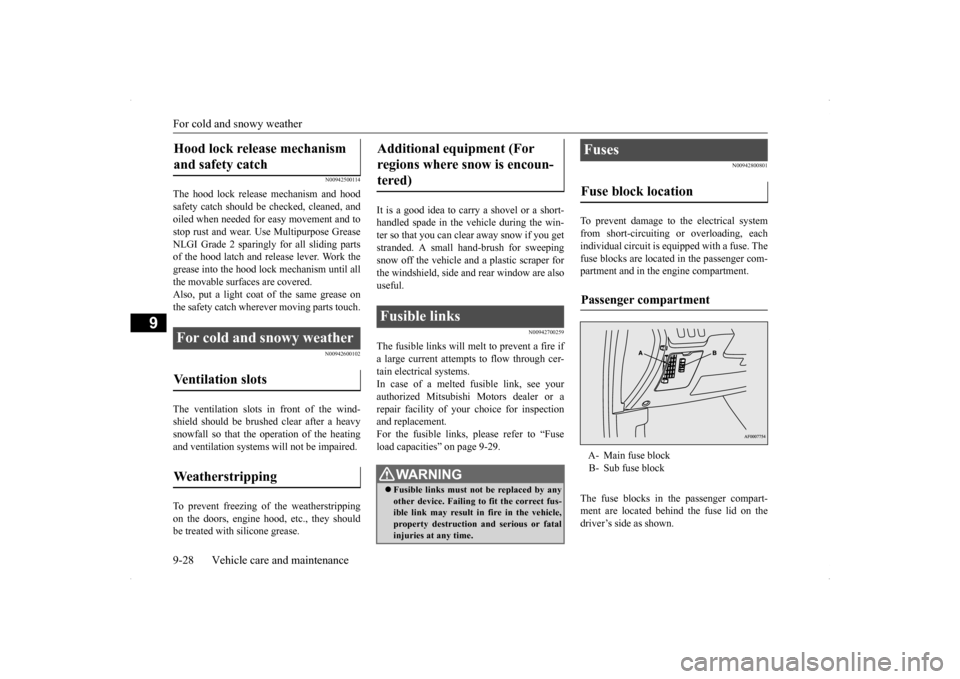
For cold and snowy weather 9-28 Vehicle care and maintenance
9
N00942500114
The hood lock release mechanism and hood safety catch should be checked, cleaned, and oiled when needed for easy movement and to stop rust and wear. Use Multipurpose GreaseNLGI Grade 2 sparingly for all sliding parts of the hood latch and release lever. Work the grease into the hood lock mechanism until allthe movable surfaces are covered.Also, put a light coat of the same grease on the safety catch wherever moving parts touch.
N00942600102
The ventilation slots in front of the wind-shield should be brushed clear after a heavy snowfall so that the operation of the heatingand ventilation systems will not be impaired. To prevent freezing of the weatherstripping on the doors, engine hood, etc., they should be treated with silicone grease.
It is a good idea to carry a shovel or a short- handled spade in the vehicle during the win- ter so that you can clear away snow if you getstranded. A small hand-brush for sweeping snow off the vehicle and a plastic scraper for the windshield, side and rear window are alsouseful.
N00942700259
The fusible links will melt
to prevent a fire if
a large current attempts to flow through cer-tain electrical systems. In case of a melted fusible link, see your authorized Mitsubishi Motors dealer or arepair facility of your choice for inspection and replacement. For the fusible links, please refer to “Fuseload capacities” on page 9-29.
N00942800801
To prevent damage to the electrical systemfrom short-circuiting or overloading, eachindividual circuit is equipped with a fuse. The fuse blocks are located in the passenger com- partment and in the engine compartment. The fuse blocks in the passenger compart- ment are located behind the fuse lid on the driver’s side as shown.
Hood lock release mechanism and safety catch For cold and snowy weather Ventilation slots Weatherstripping
Additional equipment (For regions where snow is encoun- tered) Fusible links
WA R N I N G Fusible links must not be replaced by any other device. Failing to fit the correct fus- ible link may result in fire in the vehicle,property destruction and serious or fatal injuries at any time.
Fuses Fuse block location Passenger compartment A- Main fuse block B- Sub fuse block
Page 388 of 434
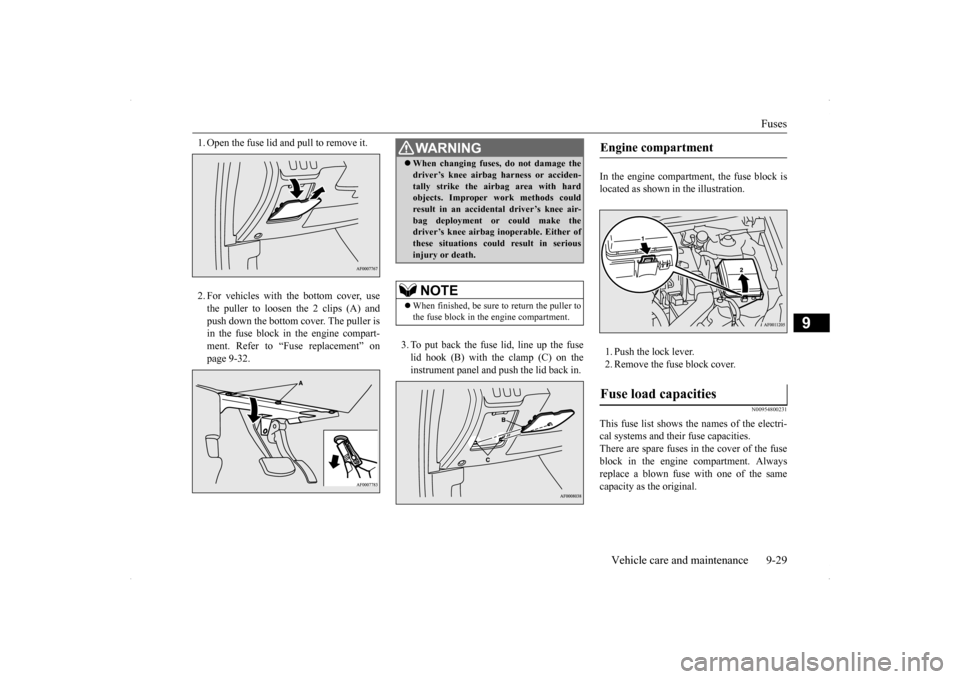
Fuses
Vehicle care and maintenance 9-29
9
1. Open the fuse lid and pull to remove it. 2. For vehicles with the bottom cover, use the puller to loosen the 2 clips (A) and push down the bottom cover. The puller is in the fuse block in the engine compart-ment. Refer to “Fuse replacement” on page 9-32.
3. To put back the fuse lid, line up the fuse lid hook (B) with the clamp (C) on theinstrument panel and push the lid back in.
In the engine compartment, the fuse block is located as shown in the illustration. 1. Push the lock lever. 2. Remove the fuse block cover.
N00954800231
This fuse list shows the names of the electri- cal systems and their fuse capacities. There are spare fuses in the cover of the fuseblock in the engine compartment. Always replace a blown fuse with one of the same capacity as the original.
WA R N I N G When changing fuses, do not damage the driver’s knee airbag harness or acciden- tally strike the airbag area with hard objects. Improper work methods could result in an accidental driver’s knee air-bag deployment or could make the driver’s knee airbag inoperable. Either of these situations could result in seriousinjury or death.NOTE
When finished, be sure to return the puller to the fuse block in the engine compartment.
Engine compartment Fuse load capacities
Page 421 of 434
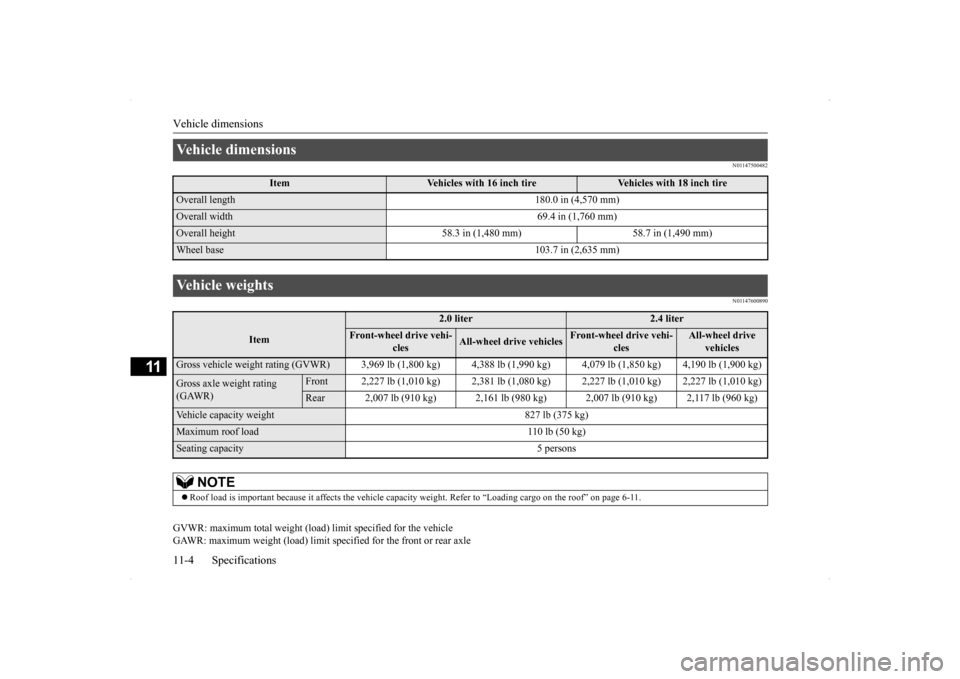
Vehicle dimensions 11-4 Specifications
11
N01147500482 N01147600890
GVWR: maximum total weight (load) limit specified for the vehicle GAWR: maximum weight (load) limit sp
ecified for the front or rear axle
Vehicle dimensions
Item
Vehicles with 16 inch tire
Vehicles with 18 inch tire
Overall length 180.0 in (4,570 mm) Overall width 69.4 in (1,760 mm) Overall height 58.3 in (1,480 mm) 58.7 in (1,490 mm)Wheel base 103.7 in (2,635 mm) Vehicle weights
Item
2.0 liter
2.4 liter
Front-wheel drive vehi-
cles
All-wheel drive vehicles
Front-wheel drive vehi-
cles
All-wheel drive
vehicles
Gross vehicle weight rating (GVWR) 3,969 lb (1,800 kg
) 4,388 lb (1,990 kg) 4,079 lb (
1,850 kg) 4,190 lb (1,900 kg)
Gross axle weight rating (GAWR)
Front 2,227 lb (1,010 kg) 2,381 lb (1,080 kg)
2,227 lb (1,010 kg) 2,227 lb (1,010 kg)
Rear 2,007 lb (910 kg) 2,161 lb (980
kg) 2,007 lb (910 kg) 2,117 lb (960 kg)
Vehicle capacity weight 827 lb (375 kg)Maximum roof load 110 lb (50 kg)Seating capacity 5 persons
NOTE
Roof load is important because it affects the vehicle capacity
weight. Refer to “Loading cargo on the roof” on page 6-11.
Page 423 of 434
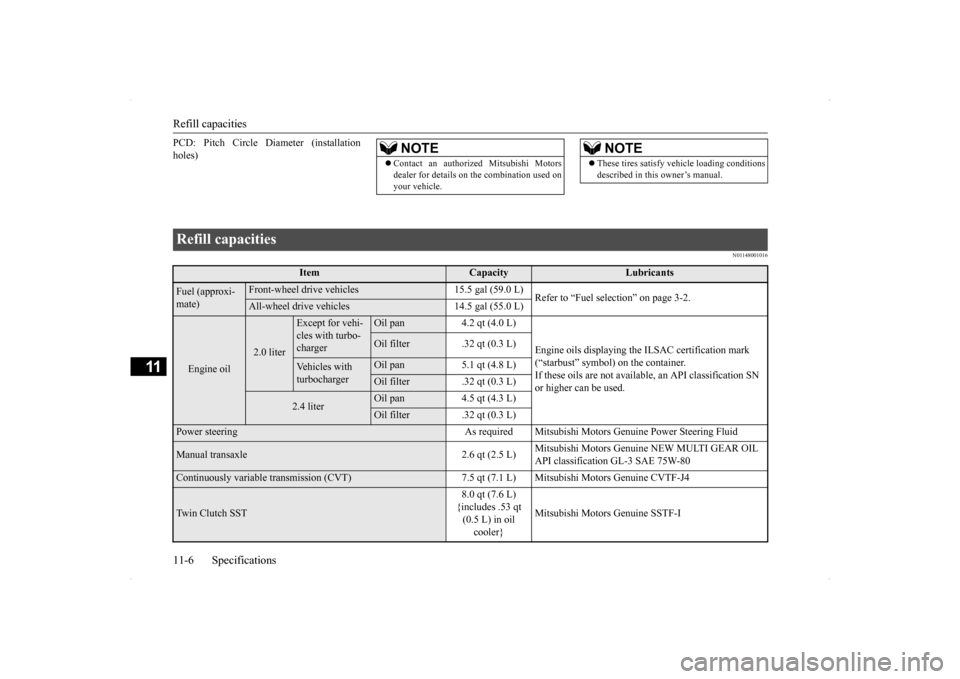
Refill capacities 11-6 Specifications
11
PCD: Pitch Circle Diameter (installation holes)
N01148001016
NOTE
Contact an authorized Mitsubishi Motors dealer for details on the combination used on your vehicle.
These tires satisfy vehicle loading conditions described in this owner’s manual.NOTE
Refill capacities
Item
Capacity
Lubricants
Fuel (approxi- mate)
Front-wheel drive vehicles 15.5 gal (59.0 L)
Refer to “Fuel selection” on page 3-2.
All-wheel drive vehicles 14.5 gal (55.0 L)
Engine oil
2.0 liter
Except for vehi- cles with turbo- charger
Oil pan 4.2 qt (4.0 L)
Engine oils displaying the ILSAC certification mark (“starbust” symbol) on the container.If these oils are not available, an API classification SN or higher can be used.
Oil filter .32 qt (0.3 L)
Vehicles with turbocharger
Oil pan 5.1 qt (4.8 L)Oil filter .32 qt (0.3 L)
2.4 liter
Oil pan 4.5 qt (4.3 L)Oil filter .32 qt (0.3 L)
Power steering As required Mitsubishi Motors Genuine Power Steering Fluid Manual transaxle 2.6 qt (2.5 L)
Mitsubishi Motors Genuine NEW MULTI GEAR OIL API classification GL-3 SAE 75W-80
Continuously variable transmission (CVT) 7.5
qt (7.1 L) Mitsubishi Motors Genuine CVTF-J4
Twin Clutch SST
8.0 qt (7.6 L) {includes .53 qt (0.5 L) in oil cooler}
Mitsubishi Motors Genuine SSTF-I
Page 424 of 434
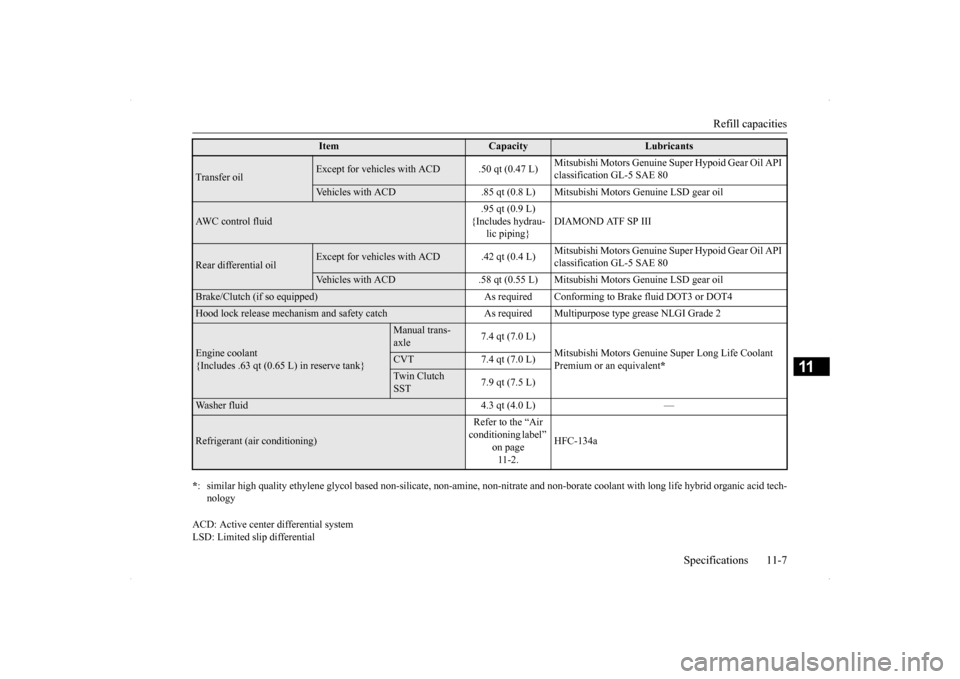
Refill capacities
Specifications 11-7
11
ACD: Active center differential system LSD: Limited slip differentialTransfer oil
Except for vehicles with ACD .50 qt (0.47 L)
Mitsubishi Motors Genuine Super Hypoid Gear Oil API classification GL-5 SAE 80
Vehicles with ACD .85 qt (0.8 L) Mitsubishi Motors Genuine LSD gear oil
AWC control fluid
.95 qt (0.9 L) {Includes hydrau-
lic piping}
DIAMOND ATF SP III
Rear differential oil
Except for vehicles with ACD .42 qt (0.4 L)
Mitsubishi Motors Genuine Super Hypoid Gear Oil API classification GL-5 SAE 80
Vehicles with ACD .58 qt (0.55 L) Mits
ubishi Motors Genuine LSD gear oil
Brake/Clutch (if so equipped) As required C
onforming to Brake fluid DOT3 or DOT4
Hood lock release mechanism and safety catch As
required Multipurpose type grease NLGI Grade 2
Engine coolant {Includes .63 qt (0.65 L) in reserve tank}
Manual trans- axle
7.4 qt (7.0 L)
Mitsubishi Motors Genuine Super Long Life Coolant Premium or an equivalent
*
CVT 7.4 qt (7.0 L)Twin Clutch SST
7.9 qt (7.5 L)
Washer fluid 4.3 qt (4.0 L) — Refrigerant (air conditioning)
Refer to the “Air conditioning label”
on page 11-2.
HFC-134a
* : similar high quality ethylene glycol base
d non-silicate, non-amine, non-nitrate a
nd non-borate coolant with long life hybrid o
rganic acid tech-
nology
Item
Capacity
Lubricants
Page 433 of 434
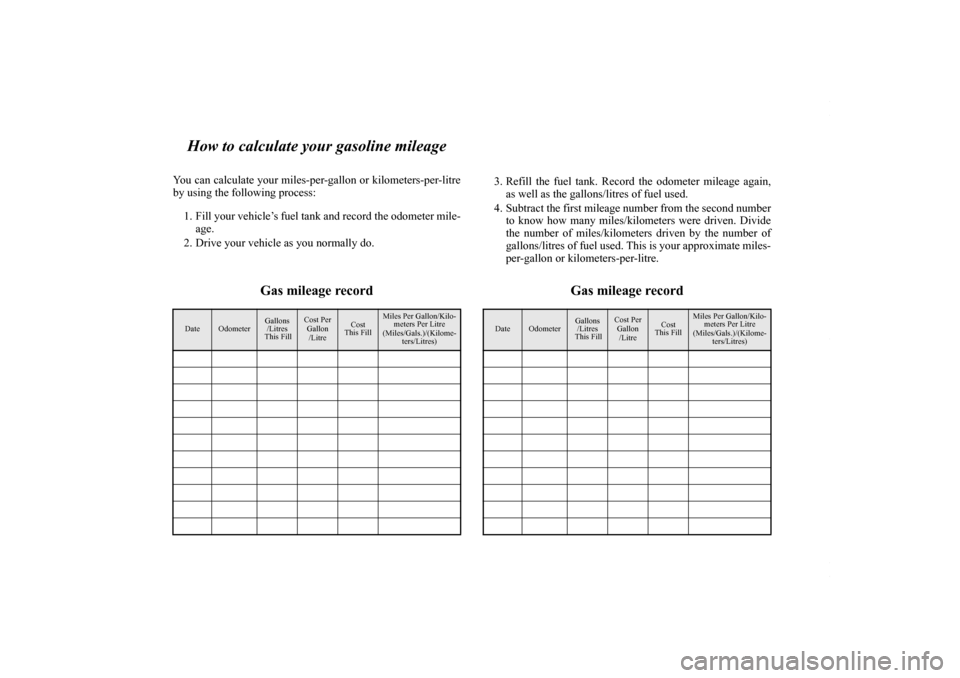
How to calculate your gasoline mileage
You can calculate your miles-per-gallon or kilometers-per-litre by using the following process: 1. Fill your vehicle’s fuel tank and record the odometer mile-
age.
2. Drive your vehicle as you normally do.
3. Refill the fuel tank. Record the odometer mileage again,
as well as the gallons/litres of fuel used.
4. Subtract the first mileage number from the second number
to know how many miles/kilometers were driven. Dividethe number of miles/kilometers driven by the number of gallons/litres of fuel used. This is your approximate miles- per-gallon or kilometers-per-litre.
Gas mileage record Gas mileage record
Date
Odometer
Gallons /Litres This Fill
Cost Per Gallon/Litre
Cost This Fill
Miles Per Gallon/Kilo- meters Per Litre (Miles/Gals.)/(Kilome-
ters/Litres)
Date
Odometer
Gallons/Litres This Fill
Cost Per Gallon/Litre
Cost This Fill
Miles Per Gallon/Kilo- meters Per Litre (Miles/Gals.)/(Kilome-
ters/Litres)
10GS41(NAFTA)_BK0102103US_lastpage.fm 1
ページ
2009年9月22日 火曜日 午後2時37分